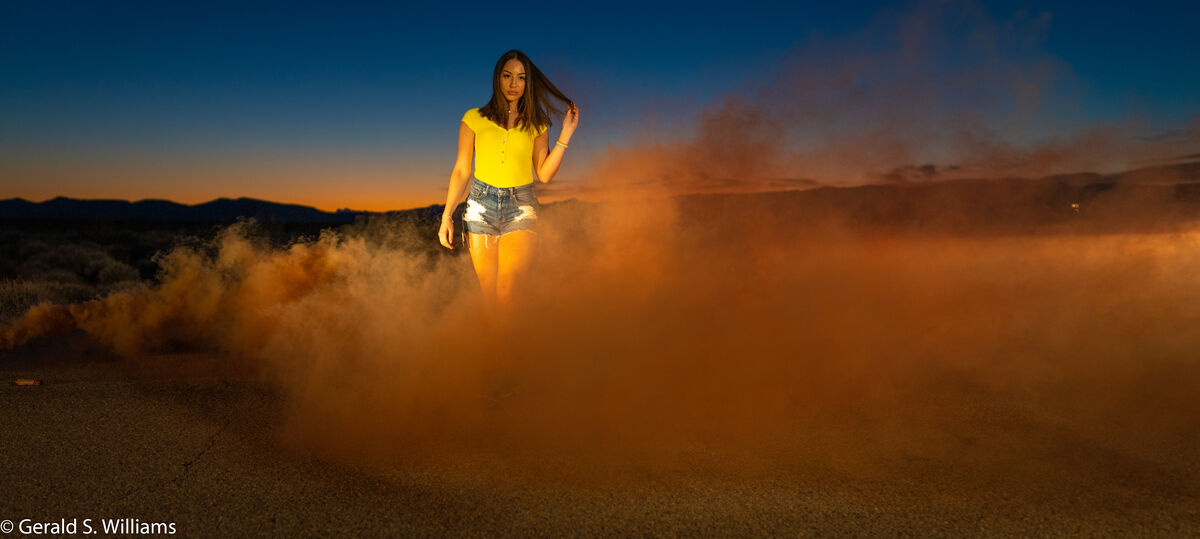Prime or zoom lenses -- does it even matter these days?
Feb 3, 2024 14:53:44 #
Feb 3, 2024 14:55:45 #
Hanson wrote:
Advantages (IQ, weight, price, speed etc) can be huge for prime over zoom in many cases. Zoom offers variabilities. If a phone satisfies you needs, yes, you may forget about prime or zoom altogether.
The latest high end smartphones are fantastic for casual photography and snapshots. But nothing beats the latest generation of cameras and lenses for versatility and ultimate quality. The good news is, unless you're doing something deliberative or important, a smartphone is probably sufficient.
Feb 3, 2024 14:57:21 #
swimweb1
Loc: Webster, NY
If I am at my grandkids soccer game taking photos, one moment the action is close and the next moment it is at the other end of the field. A zoom such as the Tamron 18-300 is worth its weight in gold. I cannot envision trying to take action soccer photos with a prime.
Like wise, if I am on vacation with my wife on a cruise or a bus trip, I don't want to hold her up (or the rest of the group) as I attempt to keep changing primes.
I have all zooms (10-24, 55-140, and 18-300 for Fujifilm APSC) and one prime (30 f1.4). The 30 f1.4 is for indoor low light photos of the family. I recently purchased the 55-140 f2.8 for late day or night soccer game photographs where I need a faster lens than the Tamron 18-300. For daytime soccer games with lots of light I use the Tamron 18-300.
Like wise, if I am on vacation with my wife on a cruise or a bus trip, I don't want to hold her up (or the rest of the group) as I attempt to keep changing primes.
I have all zooms (10-24, 55-140, and 18-300 for Fujifilm APSC) and one prime (30 f1.4). The 30 f1.4 is for indoor low light photos of the family. I recently purchased the 55-140 f2.8 for late day or night soccer game photographs where I need a faster lens than the Tamron 18-300. For daytime soccer games with lots of light I use the Tamron 18-300.
Feb 3, 2024 15:53:38 #
JZA B1 wrote:
I understand that prime lenses usually offer higher image quality. But given the fact that people use smart phones to take pics these days and quality seems to be good enough, does it even matter that primes offer slight advantage while having major disadvantage of fixed focal length?
Do you still use primes at all? For what purpose?
Do you still use primes at all? For what purpose?
After I saw the results I was getting from my Sony 70-300 G lens, I never looked back. I started in the '70's and zooms were crap, I had all primes from Canon, 200/2.8, 100/4 macro, 50/1.4, 24/2.8. So far my Sony collections is a Zeiss 35/2.8 for it's size, Zeiss 55 got when I got the a7ii body, the 70-300, an Minolta 50 macro with adapter, and 200-600. The 70-300 is the most used due to it's close focus and it's range. Great hiking lens and can throw the 35 in my pocket for those wider shots.
Feb 3, 2024 15:55:33 #
JZA B1 wrote:
I understand that prime lenses usually offer higher image quality. But given the fact that people use smart phones to take pics these days and quality seems to be good enough, does it even matter that primes offer slight advantage while having major disadvantage of fixed focal length?
Do you still use primes at all? For what purpose?
Do you still use primes at all? For what purpose?
I currently have four lenses that cover 24mm in my kit; the Tamron 17-28mm f2.8 lens; the Sony 24mm f1.4 GM lens; the Sigma Art 24-70mm f2.8 DG DN; and the Sony 24-105mm f4 G OSS lens, that were bought at different times for different purposes.
1) The Tamron 17-28mm f2.8 lens, sunrise over famed Monument Valley scene of countless movies, TV shows, commercials, Navajo lands, Arizona/Utah border, USA. 61mp Sony A7RIV, 28mm, ISO 100, f22 (to get the max sun stars), 1/125 sec.
2) The Sony 24mm f1.4 GM. Jade at sunset in the Nevada Desert, USA. 61mp Sony A7RIV, 24mm, ISO 400, f1.6, 1/160 sec. Here the f1.4 came in handy. The only light was from the headlights of two cars, with added non-flammable colored smoke added on site. This Sony 24mm f1.4 GM is considered among the sharpest 24mm lenses ever made, even wide open at f1.4. .
3) The Sigma Art 24-70mm f2.8 DG DN lens. The Golden Gate Bridge, San Francisco, California, USA. 61mp Sony A7RIV, 24mm, ISO 200, f8, 1/80 sec., handheld. This lens is superbly sharp.
4) The Sony 24-105mm f4 G OSS lens, bought first among these four lenses. A photo that was chosen as a Worldwide Photo of the Week by Sony Alpha Photographers in 2021. Environmental Scientist Brooke Hildebrand in a slot canyon near Upper Antelope Canyon, Navajo lands, Page, Arizona, USA. 24mp Sony A9, 24mm, ISO 400, f4, 1/30 sec., handheld, all natural sunlight only ,in the slot canyon. I could only take one camera and one lens with me into the canyon so this gave me a range of focal lengths, that I would not have had with a prime.
5) The Sony 24-105mm f4 G OSS lens again, showing its focal length versatility. A Parrot in flight on the Caribbean Island of Sint Maarten/St. Martin, 50mp Sony A1, 105mm , ISO 1600, f 4, 1/2000 sec., handheld, all natural sunlight.
Click on download to see better image quality.
Cheers and best to you all.
Feb 3, 2024 16:13:20 #
I'll stipulate that the best modern zooms from all manufacturers are mostly equal to primes in quality.
Even budget zooms are usually pretty good.
But the reasons we choose one over the other are as varied as the photographers who use them.
The two biggest determinants of what you choose are preference and budget, followed by the type of photography you do.
For most people, photography is an enjoyable hobby. Use what makes you happy
Some lenses have a 'look', ---that people find satisfying, but as lenses have gotten 'better' they became more similar because of CAD
I was a photographer for 20 years before I owned a zoom, but a long time ago Primes WERE generally better .
But now I probably have more zooms than primes.
I started with Nikon and Changed to Canon for Digital, really only because at the time Nikon did not have a FF camera, and my Nikon Rep was telling me FF wasn't necessary for digital.
I find the latest versions of f/2.8 zooms to be really wonderful. But because of my prime background I tend to use lenses like a 24-70 as dual focal length lenses. Probably 90% of pictures I take with that lens are either 24 OR 70.
There is a reason for that , I see and roughly frame pictures before I raise the camera to my eye. I decide "is this a wide picture or a Tele picture then flick the zoom ring to either extreme on the way to my eye.
Because I 'know' what 24mm or 70mm looks like, I can see them. 37mm or 61, not so much.
Limitations can make for better pictures. Many really great photographers used primarily one lens because it suited their vision. Now I am not suggesting anyone else do this, it is just what I do.
I only share this because asking a large group of people which to use , or if there is still a reason to use primes, is a question that doesn't get you any useful information.
What kind of pictures do you aspire to take? What stories do you want to tell? What do YOU need to do that? let that be your guide
Even budget zooms are usually pretty good.
But the reasons we choose one over the other are as varied as the photographers who use them.
The two biggest determinants of what you choose are preference and budget, followed by the type of photography you do.
For most people, photography is an enjoyable hobby. Use what makes you happy
Some lenses have a 'look', ---that people find satisfying, but as lenses have gotten 'better' they became more similar because of CAD
I was a photographer for 20 years before I owned a zoom, but a long time ago Primes WERE generally better .
But now I probably have more zooms than primes.
I started with Nikon and Changed to Canon for Digital, really only because at the time Nikon did not have a FF camera, and my Nikon Rep was telling me FF wasn't necessary for digital.
I find the latest versions of f/2.8 zooms to be really wonderful. But because of my prime background I tend to use lenses like a 24-70 as dual focal length lenses. Probably 90% of pictures I take with that lens are either 24 OR 70.
There is a reason for that , I see and roughly frame pictures before I raise the camera to my eye. I decide "is this a wide picture or a Tele picture then flick the zoom ring to either extreme on the way to my eye.
Because I 'know' what 24mm or 70mm looks like, I can see them. 37mm or 61, not so much.
Limitations can make for better pictures. Many really great photographers used primarily one lens because it suited their vision. Now I am not suggesting anyone else do this, it is just what I do.
I only share this because asking a large group of people which to use , or if there is still a reason to use primes, is a question that doesn't get you any useful information.
What kind of pictures do you aspire to take? What stories do you want to tell? What do YOU need to do that? let that be your guide
Feb 3, 2024 16:19:07 #
User ID wrote:
The bigger the gear the duller the pix. Its a rather definitive quotient, clearly observable throughout photography. Your denial of that hints that you lean toward the bigger gear.
Is there some reason you want to insult a big chunk of the people on this sight or are you just totaly oblivious.
I shoot sports for a living. Just try that on a phone. You have given absolutely no evidence for your assertion.
Are you trying to claim that photographers like Moose Peterson or Tom Jenkins shoot dull pix?
Give me a break
Feb 3, 2024 16:24:56 #
Mac wrote:
The comments and opinions expressed in this thread are informative and enlightening. It appears that Prime or Zoom doesn’t really matter at all. It used to be that photographers would do all they could to make a photograph as good as possible. Now, with the number of times the phrase is used in this thread, good enough seems to be the ultimate goal.
The goal posts have moved. Lens Technology has been concentrated on improving zooms. There are now "Prime Zooms" and "Super Zooms".
"Good enough" belongs to the 21st century and the modern generations, rather than the 20th century and the pursuit of excellence.
Feb 3, 2024 16:38:28 #
JZA B1 wrote:
I understand that prime lenses usually offer higher image quality. But given the fact that people use smart phones to take pics these days and quality seems to be good enough, does it even matter that primes offer slight advantage while having major disadvantage of fixed focal length?
Do you still use primes at all? For what purpose?
Do you still use primes at all? For what purpose?
I have both…primes are smaller and lighter generally. IQ is arguably better with primes…but in reality that’s mostly at the pixel peeping level. Depending on your output destination…in particular for screen output the resolution is going to be doensampled considerably and those pixel peeping differences are pretty much gone in the downsampling process. Which one I take today depends on a variety of factors…weight, size, flexibility, irreplaceability of the photos, am I hiking or working mostly out of the car, dedicated photo outing vs walkabout, and more.
Feb 3, 2024 16:41:07 #
btbg wrote:
Sigma Sport 150-600 is a pretty good lens for the price, but it can't touch the Nikon Z400 f2.8.
That’s a completely ludicrous comparison…the lenses aren’t in the same state price wise and are intended for different uses.
Feb 3, 2024 17:57:42 #
Jamie C
Loc: Indialantic, Florida
I have a prime lens at F/1.7 - I haven't found a Zoom lens that can even get close to the speed, unless of course it costs as much as my home.
My Canon M mount zoom lenses are quite light, but again relatively slow. Just 1 or 1.5 stops faster means less noise (better/smaller ISO needed), and less motion blur. Also a fast lens will allow for Bokeh that's a bit more difficult to capture with even a F/2.4. Of course, you can use an AI enabled photo editor, the great equalizer, to do that.
I use both all the time. Like all things, choose the right tool for the job.
My Canon M mount zoom lenses are quite light, but again relatively slow. Just 1 or 1.5 stops faster means less noise (better/smaller ISO needed), and less motion blur. Also a fast lens will allow for Bokeh that's a bit more difficult to capture with even a F/2.4. Of course, you can use an AI enabled photo editor, the great equalizer, to do that.
I use both all the time. Like all things, choose the right tool for the job.
Feb 3, 2024 18:14:23 #
Jamie C
Loc: Indialantic, Florida
Delderby wrote:
The goal posts have moved. Lens Technology has been concentrated on improving zooms. There are now "Prime Zooms" and "Super Zooms".
"Good enough" belongs to the 21st century and the modern generations, rather than the 20th century and the pursuit of excellence.
"Good enough" belongs to the 21st century and the modern generations, rather than the 20th century and the pursuit of excellence.
As someone who makes a living design lenses (have 3 new ones in various fab houses), I can tell you the optics in phones like the Pixel use "free form" optics (ie very complex shapes expressed only by polynomial surface equations that are enabled by design software and very new methods to shape and polish glass. Cell phone cameras use these instead of the conventional lenses that use spherical surfaces of aspheric profile with circular symmetry.
So these new camera miniature lenses have very sophisticated lens designs. But the miraculous images viewed have been already enhanced by a neural engine in the phone. This is a basic form of AI. Apple now puts these neural engines directly into thie M1 and M2 chips and all devices use these or a derivative. Google and Samsung may have these neural engines too but I am not certain.
Your digital camera does not use these, instead opting for creative integrity. I anticipate that most all ya'all use some sort of AI enable photo editor or add-in to the same. I just use LightRoom and PhotoShop.
Feb 3, 2024 18:15:06 #
Jamie C wrote:
I have a prime lens at F/1.7 - I haven't found a Z... (show quote)
The Leica D-LUX (typ 109) has a fixed 3x zoom F1.7 lens - very sharp! They currently change hands on ebay UK circa £600.
Feb 3, 2024 18:30:19 #
Jamie C
Loc: Indialantic, Florida
btbg wrote:
Is there some reason you want to insult a big chunk of the people on this sight or are you just totaly oblivious.
I shoot sports for a living. Just try that on a phone. You have given absolutely no evidence for your assertion.
Are you trying to claim that photographers like Moose Peterson or Tom Jenkins shoot dull pix?
Give me a break
I shoot sports for a living. Just try that on a phone. You have given absolutely no evidence for your assertion.
Are you trying to claim that photographers like Moose Peterson or Tom Jenkins shoot dull pix?
Give me a break
I believe there may be a misapprehension here. "Duller" may mean less dynamic range. This occurs when the image data has ghost reflections from any pair of surfaces that create double reflection in the lens since all surfaces reflect some light. Take the potential number of distinct surfaces pairs and each adds some background stray light that falls randomly on the sensor.
Point is that the more surfaces provide more stray light that can only diminish the actual image. The camera may to a black clip to eliminate some of this but it's using maybe 2-3 bits of your 12-14-16 bit A/D dynamic range.
Then, when looking at a Prime lens versus a Zoom, you will find at 1.5x to 3x more elements. Thus the image may not have the full range, ie appear "duller." This occurs whether film and digital.
I really don't believe that this poster had any intent to insult, denigrate, or criticize. I may be wrong but UHH seems to have a angry posts. That's why I seldom visit.
Waiting for some nice responses...
Feb 3, 2024 18:40:45 #
Timmers wrote:
Oh, it matters. Portrait using the 8.5cm, f1.5 Summarex lens made in 1968 on Tri-X film.
The other lens is the classic Leica Summar 5cm f2 lens.
The other lens is the classic Leica Summar 5cm f2 lens.
You don't think that portrait could have been done just as well or maybe even better with today's quality short range f2.8 zoom?
If you want to reply, then register here. Registration is free and your account is created instantly, so you can post right away.







